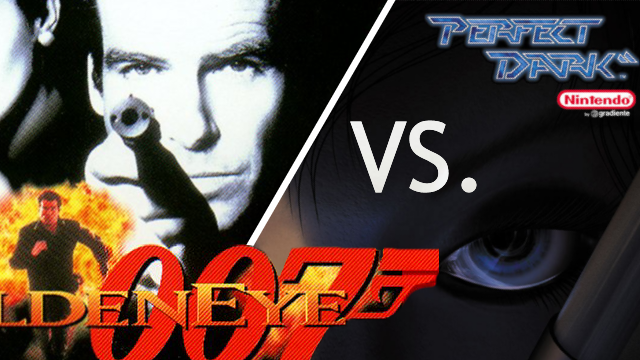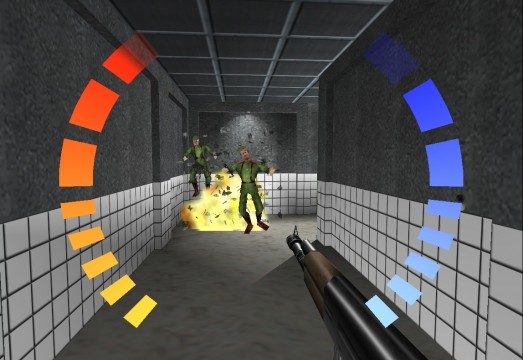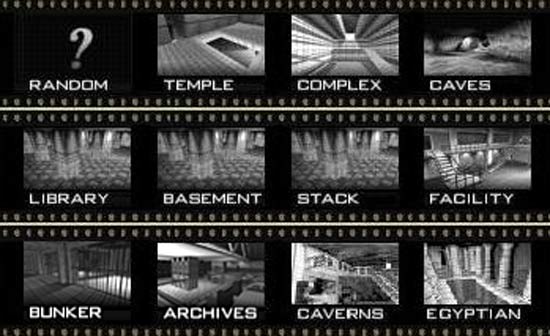
A Golden Argument by Josh Johnston
Now, some would no doubt try to argue that Perfect Dark is superior. They are liable to argue that it is a more refined and polished shooter. Their arguments are certainly interesting but I ultimately find them unconvincing. In my view, GoldenEye is far and away the better game, and that superiority boils down to three simple truths.
GoldenEye has better source material
Even in a multiplayer-focused shooter, atmosphere is important. Perfect Dark is The Conduit of its day, a pretty, generic science fiction shooter with a throwaway plot, setting, and characters. The whole business in the game about some interstellar war playing out on Earth doesn’t deliver much drama, as it is little more than a staging ground for blowing things up. The characters, too, are little more than generic cutouts to deploy on the map. Joanna herself is the worst offender, a Lara Croft in space that comes fully armed with looks but is rather lacking in substance. Like her, her world proves to be entertaining at times but ultimately saccharine. It doesn’t have to be this way: games like Halo and Gears of War have managed to have their cake and blow it up, too.
GoldenEye, by contrast, is an adaptation of one of the better James Bond films ever made. As it is based on a Hollywood script, the single player campaign plays out like a Hollywood movie. There are dramatic twists right from the start, and the game is heavy both on action and on good drama, with the immortal Bond at the center of it all. As a bonus, completing the single-player unlocks some fan-favorite (and wickedly difficult) locations taken from other James Bond films.

All of this translates brilliantly over to the multiplayer. Rather than being generic settings, everything matters. The weapons, like the PP7 and the Golden Gun, are drawn straight out of Bond lore. The locations are a tribute to GoldenEye and other movies in the franchise. And the characters are just north of awesome: really, can anyone in Perfect Dark really compete with Jaws and Oddjob?
GoldenEye does more with less
A game can only be properly understood in the context of its time; Chrono Trigger is revered, not because it looks better or plays deeper than a modern game, but because it maximized the system it was on in the time it was released. Likewise, as GoldenEye was released in 1997 and Perfect Dark was released in 2000, they operate in somewhat different contexts. Rare developed both and was thus able to use refined techniques with Perfect Dark, including use of the Expansion Pak, which added RAM to the system.
In the context of its time, GoldenEye did more with its lot than Perfect Dark did. GoldenEye managed to deliver a gloriously chaotic four-player multiplayer experience without the Expansion Pak, and for a freshman Nintendo 64 effort it looks and plays great. It is also a compelling world, something Perfect Dark, with its three extra years, was never able to match. Perhaps most telling of all, it is interesting to see how many of the major game engine and mechanics got imported wholesale from GoldenEye to Perfect Dark, a testament to just how right Rare got it the first time.
GoldenEye’s legacy is stronger
To be sure, the Perfect Dark franchise certainly has been prolific, including three subsequent games, a remake, plus a handful of novels and comic books. That’s all fine, but it doesn’t really amount to as much as it sounds. After all, no one reminisces about Xbox 360’s Perfect Dark Zero, and I’ve never seen anyone bury their nose in Perfect Dark novels like they do the likes of Halo or Gears of War. Even with the original, don’t expect a celebration: ask most people about Perfect Dark and you’ll get respectable chatter, no more, no less.

GoldenEye, meanwhile, is its own cult. Go into a room of GenX-ers and say the word “GoldenEye” and even the casual gamers will immediately light up, going on and on about the hours they spent playing that four-player shooter back in the day. What’s remarkable is that they won’t readily think of the movie– that’s right, the game has achieved such a mythical status that it actually overshadows the blockbuster Pierce Brosnan film it was based on.
These are not merely anecdotal observations. Sales for GoldenEye more than doubled that of Perfect Dark, and GoldenEye was the only game among the top ten all-time sales list for Nintendo 64 to be based on something other than a staple Nintendo property. That commercial success only reinforces what personal experience has long suspected: at the end of the day, Perfect Dark is a solid, polished shooter, but GoldenEye is the stuff of legend.




 ShareThis
ShareThis







While the subject material for this article is brilliant in and of itself, there seems to be a few key points that are interestingly nowhere to be seen.
Truly, GoldenEye’s entrance was an absolute first for not only the Nintendo market, but for the home console market simultaneously. Gamers all knew of Doom and Wolfenstein on the P.C., but back in ’97, not everyone had one of those yet. It was still on the up-and-coming angle rather than the accepted dominance it now holds. Knowing of the idea of a FPS, never-mind one that you can play with friends, Josh is quite right in that when GoldenEye landed, it did -everything- right.
However, one of the main points that is missed here is that GoldenEye did more with the N64 than Perfect Dark did, because Perfect Dark established elements within it’s game that quite honestly did not fit in with the limitations on the N64. One of the first and foremost examples of this are the bots. The minute you get a Perfect Sim (never-mind a Dark-Sim) playing against yourself, you understand that it’s accuracy, or rather, it’s ability to head-shot you straight-on regardless of the direction is was facing half a second before, quite literally makes the human player unable to respond as quickly because they are dealing with the “controller lag” of the N64 controller. Turning around (never mind getting your sights on your foe) took time. Time that the Perfect Sims did not have to take.
To put it simply, the Perfect Sims were playing with a mouse and keyboard, and the human player was stuck with his N64 controller, although great, could not force the “screen box” to move at the same speed as the computer A.I. And we all know what this kind of scenario produces in grand quantity: frustration.
The next issue between GoldenEye and Perfect Dark is that of weapon balance. Quite simply put, in GoldenEye, for the most part, you were playing with guns. Guns that shot bullets. Sure, you had mines, and rockets, and grenades, and what-not, but for the most part, the multi-player game focused itself around who landed that wicked-sick head-shot, or who just did an amazing corner-to-corner drive by sub-machine gun run. It felt that everyone was on the same page at least, when it came to weapon balance, selection, and use. Not to mention that the weapons you used were in pre-determined packs, so you only had roughly 7-10 weapon selections available, whereas in Perfect Dark, you could choose whichever six weapons you desired.
Although the latter example here sounds like it would make for greater game-play, too many of the weapons in Perfect Dark had secondary features that were either a) useless, or b) over-powered the regular feature to an uncanny extent. Not only this, but wanting to just have basic run-and-gun multi-player set-ups meant that, in reality, you could only really choose like four or five of the semi-automatics available. The CP32 (I think that’s what it was called) had the auto-lock on feature. That’s pretty much auto-B.S. as far as a shoot-out is concerned. The Dragon had the proximity mine feature, meaning if you wanted an explosive-free match, you couldn’t add this incredible machine gun. The Super-Dragon had a grenade launcher as it’s secondary weapon (really? C’mon). The lap-top gun had the sentry gun, which although awesome in concept, was just way too deadly in execution.
In short, the secondary weapon features, which although a great concept, and great ideas for the features themselves, did not balance evenly whatsoever. Whatever game-play type you were going for in multi-player, it would soon be discovered that you had very few weapons to compliment your existing choices well.
And finally, and this is a point that Josh hits upon excellently in his article, the story for the single player game (back when single player games mattered for console shooters) was hands-down way better in GoldenEye. Not only this, but the shoot-outs were way more, I know this is a weird way to say this, relate-able. Going through the Facility level, having tons of Russian soldiers streaming at you from all directions, yeah, you could buy into this. Dinking around on an alien planet/space ship in Perfect Dark, having to listen to Elvis; mind-breaking annoyance.
Not only that, but the actual level designs were far tighter in GoldenEye than in Perfect Dark. Perfect Dark had some amazing locales that did vary from one another, but it took risks on many of those locales as well, that quite honestly did not translate to fun game-play. A show of hands here of who enjoyed the last “boss” level of Perfect Dark? Really? You did? Get out. Now. Actually, any level in Perfect Dark that had the Aliens in it were really annoying, and, if not exactly boring, were not “Oh man! That was awesome!” excitement inducing. Which, by the way, every single level of GoldenEye was.
Perfect Dark had a lot of work cut out for it. Not only was it a “sequel” to a break-through and (then) one-of-a-kind game (based, none-the-less, on one of the oldest and prolific movie licenses ever), it was expected, no-doubt, to provide the same kind of splash as the original had. That’s a huge piece of work cut out for a game based on an original property. And never-the-less, RARE did an amazing job adding an incredible amount of content on-to what was then considered one of the most complete experiences available on the N64. That being said, much of what made the cut to the final floor of Perfect Dark shouldn’t have. There should have been someone at RARE that was just super-honest with the entire team, and stated, “Yo Brits and Grits – we can do better.” They had an amazing amount of new features, but lacking the aforementioned balance, had no hope of ever topping, never-mind meeting, a game as well thought-out and balanced as the original GoldenEye.
And that is where Perfect Dark ultimately fell short. Not on the amazing promises it made and delivered, but how it made those promises sit and interact with one another on the same cartridge. This article by Josh and Katharine hit upon many valiant points, but ultimately miss a few very timely ones as why Perfect Dark did only sell half the amount as GoldenEye, and why a room lights up at the mention of GoldenEye, but produces many furrowed brows at the mention of Joanna Dark. Ultimately, at the end of the day, what moved both of these experiences was the very reason you would tell some-one you were going to be picking either one of them up from the store; “I’m going to buy a game.” And in terms of game-play, GoldenEye is the clear and cut example, as stated by Josh, of how to get it absolutely right the first time around, whereas Perfect Dark missed it’s mark (by perhaps) adding too much without remembering that all the extras would have to come together to form a coherent package.
Regardless of this though, absolutely amusing read from both Josh and Katharine, a fine piece of Nintendo-based writing indeed.
@Diamondo: thanks for the feedback and the thoughts. I agree with the vast majority of your points, and even where I don’t, it is more a matter of weighing to what degree the fault should be held against Perfect Dark, not a matter of whether the fault exists.
For the purposes of avoiding getting overly windy, word count limits were set on the responses at the outset, which (necessarily) hampered how detailed or technical we could get… hence some of the finer details you correctly pointed out were omitted.
Thank you for the reply Joshua,
Even though I made the point of vocalizing my “Huh? Why is -this- and -that- not there?” I can fully appreciate the need to put a collar on the word-count. Not to mention how feeling of sharpness (re: of a genuine, off-the-cuff, rapid-fire exchange) can get hampered by both windy arguments, and the baggage that of course often comes with this, the sensation that the “exchange” was really just a costume for a long list of ideas.
That all being said, that’s what’s always wonderful about the comments section. Those that read, care, and wish to contribute something can always make their voice, opinions, and knowledge heard. And even though it is not part and parcel of the actual content package, it carries with it none-the-less both the continuation, and the care, of somebody who has read (and thus been motivated by) the original piece.
This being said, I still feel that perhaps there is a bit of an under-utilization of one of the really clever page-design implementations here at the Dojo (fairly) recently. This of course is the idea that (some – really – any) piece can be cut and divided into different page segments. Not only does this cut any chances of opening a page out of curiousness and then realizing, “Yeah, I wouldn’t mind discovering out more about X, but I don’t know if I have the commitment to move this tiny page-scroll bar all the way to the bottom,” but it naturally introduces breaks and sub-sections within a given piece. If I don’t know if I’m going to commit to an article, it’s a lot easier giving the few paragraphs on the first page a go-through, and then knowing if it doesn’t strike my fancy, I don’t have to go on, rather than saying to myself, “If the first few paragraphs really don’t cut it, I’m going to pull myself away from the entire article, and feel the disappointment associated with giving up regardless.” And the content, especially in a web-based format, often can call on different design principles (whether one page can be dedicated more to pictures – another quotes – a third a more in-depth dissertation) that give the article as a whole a much more well-rounded and thoroughly thought out apprehension than just a long page with everything stuck on everything else, as if soldiering up in a food line.
Sorry again for the rather lengthy response, but again, great work on the article and in general for the site. The name of Joshua carries a lot of weight when attributed to an article, not only for the guaranteed insight, but the guaranteed heart. It’s been a pleasure reading your work. Keep it up.